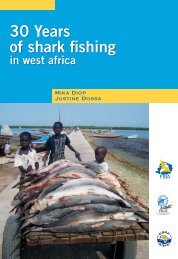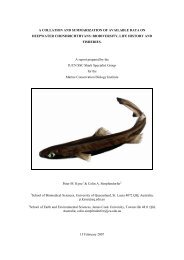Magazine of the species survival Commission specialist Group - IUCN
Magazine of the species survival Commission specialist Group - IUCN
Magazine of the species survival Commission specialist Group - IUCN
You also want an ePaper? Increase the reach of your titles
YUMPU automatically turns print PDFs into web optimized ePapers that Google loves.
<strong>specialist</strong> group exchange<br />
<strong>the</strong> diligence and hard work <strong>of</strong> our<br />
Japanese partners.<br />
Since <strong>the</strong> implementation <strong>of</strong> <strong>the</strong><br />
projects, <strong>IUCN</strong> SSG member<br />
Dr Masahide Kaeriyama has led an<br />
effort to monitor <strong>the</strong> sites. His results<br />
show that <strong>the</strong>y have succeeded in<br />
restoring <strong>the</strong> run <strong>of</strong> salmonids<br />
upstream in <strong>the</strong> Rusha River, one <strong>of</strong> <strong>the</strong><br />
most productive salmon rivers on <strong>the</strong><br />
peninsula. While returns upriver in <strong>the</strong><br />
o<strong>the</strong>r streams are still relatively low, <strong>the</strong><br />
restoration work will continue as<br />
progress is made to reach an ambitious<br />
conservation target in <strong>the</strong> coming<br />
years.<br />
Pete Rand<br />
Chair, Salmonid Specialist <strong>Group</strong><br />
Sciaenidae RLA<br />
First Red List workshop on<br />
Sciaenidae<br />
The first Red List Assessment<br />
workshop on global and Brazilian<br />
Sciaenidae was held in Brazil in<br />
November 2009. It was organized by<br />
<strong>the</strong> <strong>IUCN</strong> SSC Sciaenidae Red List<br />
Authority in conjunction with <strong>the</strong> Global<br />
Marine Species Assessment (GMSA)<br />
and <strong>the</strong> Instituto Chico Mendes de<br />
Conservação da Biodiversidade (MMA,<br />
Brazil). Participating in <strong>the</strong> workshop<br />
were 19 international <strong>specialist</strong>s from<br />
13 countries, plus 20 Brazilian<br />
<strong>specialist</strong>s and trainees.<br />
Sciaenidae fishes include 300<br />
<strong>species</strong> <strong>of</strong> croakers and drums. They<br />
are small to medium-sized bottomdwelling<br />
fish that are found in <strong>the</strong><br />
shallow warm seas and estuaries <strong>of</strong> <strong>the</strong><br />
world. They are a major coastal fishery<br />
resource.<br />
A total <strong>of</strong> 270 <strong>species</strong> were<br />
evaluated or revised during <strong>the</strong><br />
workshop. Of <strong>the</strong>se, four are Critically<br />
Endangered, six are Endangered, five<br />
are Vulnerable and four are Near<br />
Threatened. The rest <strong>of</strong> <strong>the</strong> <strong>species</strong> are<br />
ranked as Least Concern (156) and<br />
Data Deficient (70).<br />
We are currently establishing a<br />
Global Sciaenidae Conservation<br />
Network (GSCN) to collaborate on<br />
specimen and data collection, and<br />
research projects on all aspects <strong>of</strong><br />
Sciaenidae biology, fishery issues and<br />
socioeconomics.<br />
Our goal is to make a revised global<br />
Sciaenidae Red List assessment in <strong>the</strong><br />
next eight to 10 years. We have also<br />
received support for this project from<br />
Taiwan Forest Bureau’s International<br />
Conservation Grant and Bio-Amazonia<br />
Conservation International (USA).<br />
Ning Labbish Chao<br />
Focal Point, Sciaenidae Red List<br />
Authority<br />
Shark SG<br />
Streng<strong>the</strong>ning <strong>the</strong> EU ban on<br />
shark finning<br />
The <strong>IUCN</strong> SSC Shark Specialist <strong>Group</strong><br />
(SSG) has been engaged in <strong>the</strong><br />
process to streng<strong>the</strong>n <strong>the</strong> ban on shark<br />
finning (slicing <strong>of</strong>f a shark’s fins and<br />
discarding <strong>the</strong> body at sea) for one <strong>of</strong><br />
<strong>the</strong> world’s most influential shark<br />
fishing powers: <strong>the</strong> European Union<br />
(EU). The next step in this process is a<br />
long-awaited public consultation held<br />
by <strong>the</strong> European <strong>Commission</strong>, which is<br />
anticipated to begin this autumn and<br />
last for at least two months.<br />
Associated with unacceptable<br />
waste and unsustainable mortality,<br />
shark finning is driven by <strong>the</strong><br />
discrepancy between generally lowvalue<br />
shark meat and high-value shark<br />
fins, which can sell for hundreds <strong>of</strong><br />
Euros per kilogramme for use in a<br />
traditional Chinese soup. The EU<br />
banned finning in 2003, but loopholes<br />
in <strong>the</strong> regulation undermine its<br />
effectiveness. Specifically, <strong>the</strong> current<br />
EU finning regulation allows fishermen<br />
to land shark fins and carcasses in<br />
separate ports, and uses <strong>the</strong> world’s<br />
highest (and <strong>the</strong>refore most lenient) finto-carcass<br />
weight ratio limit to judge<br />
whe<strong>the</strong>r fins and bodies landed are in<br />
<strong>the</strong> appropriate proportion.<br />
The <strong>Commission</strong>’s upcoming public<br />
consultation document on <strong>the</strong> Finning<br />
Regulation is expected to solicit<br />
opinions on a range <strong>of</strong> methods for<br />
implementing <strong>the</strong> ban, including<br />
adjusted fin-to-carcass ratios and<br />
various strategies for matching fins to<br />
corresponding carcasses.<br />
The SSG has long asserted that <strong>the</strong><br />
most effective way to prevent finning is<br />
to require that sharks be landed with<br />
<strong>the</strong>ir fins naturally attached. This<br />
strategy also allows for improved<br />
<strong>species</strong>-specific landings data, which<br />
are needed for population assessments<br />
and fisheries management. The 2008<br />
<strong>IUCN</strong> World Conservation Congress<br />
adopted a global policy on finning<br />
which calls on States to end at-sea<br />
removal <strong>of</strong> shark fins.<br />
As part <strong>of</strong> <strong>the</strong>ir contributions to <strong>the</strong><br />
consultation, <strong>the</strong> SSG and <strong>the</strong><br />
European Elasmobranch Association<br />
have prepared Shark Fins in Europe:<br />
Implications for Reforming <strong>the</strong> EU<br />
Finning Ban, available on <strong>the</strong> SSG<br />
website.<br />
Finning bans alone, however, will<br />
not prevent overfishing <strong>of</strong> sharks. Catch<br />
limits based on scientific advice and <strong>the</strong><br />
precautionary approach are essential to<br />
ensure shark mortality and fisheries are<br />
sustainable. Such measures are<br />
particularly urgent for European waters<br />
where <strong>the</strong> percentage <strong>of</strong> shark <strong>species</strong><br />
classified by <strong>IUCN</strong> as Threatened is<br />
exceptionally high.<br />
Participants <strong>of</strong> <strong>the</strong> Global Sciaenidae Red List Assessment workshop, Brazil. © Sciaenidae RLA<br />
Sonja Fordham<br />
Deputy Director, Shark Specialist <strong>Group</strong><br />
<strong>species</strong> 52 • 25
















